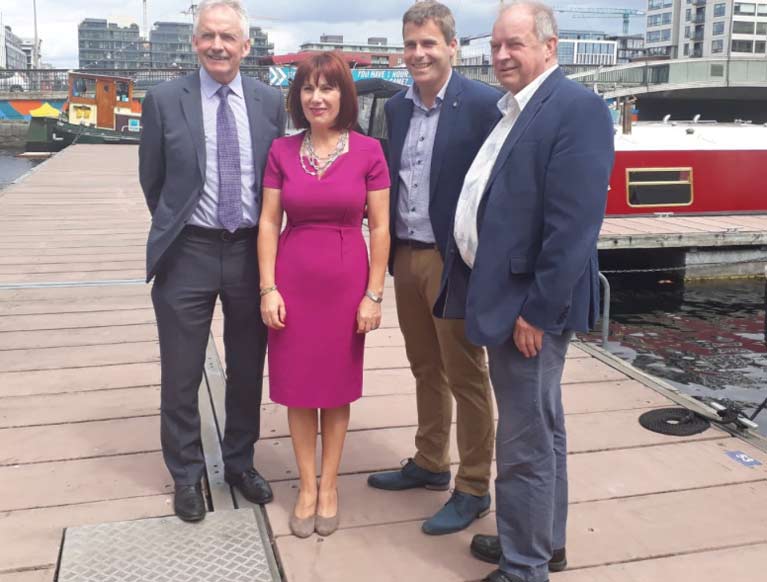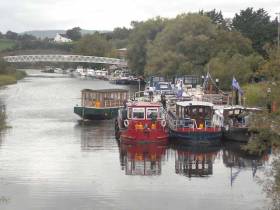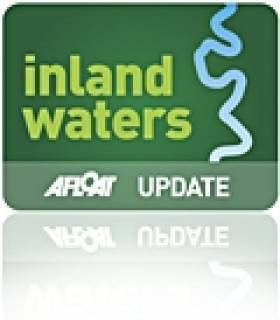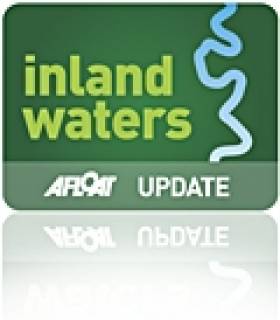Displaying items by tag: heritage boats
The Minister for Culture, Heritage and the Gaeltacht, Josepha Madigan TD, has announced the inclusion of Ireland’s Floating Heritage in the National Inventory of Intangible Cultural Heritage.
The National Inventory is intended to raise awareness of, and respect for, our unique living culture through official State recognition. The National Inventory will also fulfil Ireland’s obligations under the 2003 UNESCO Convention for the Safeguarding of the Intangible Cultural Heritage.
Intangible cultural heritage represents living forms of heritage that cannot be touched – unlike, for example, our built heritage. It refers to the practices, representations and expressions that are central to the lives and identities of our communities, groups and individuals.
Launching the Inventory recognising 30 different aspects of Intangible Heritage Minister Madigan TD said ‘It is wonderful to see such a variety of customs and traditions from all over the country being acknowledged here today. Each of these threads in the cultural tapestry of our lives makes us richer as individuals and as a country. None of this would be possible without the work of committed volunteers all around the country, whose involvement in their communities’ cultural practices and heritage traditions have sustained them over the generations. I am delighted to honour those customs, practices and traditions through official State recognition on the National Inventory.”
 Minister Madigan with John Mc Keown, Cormac Mc Carthy of Waterways Ireland and Paul Martin of the Heritage Boats Association
Minister Madigan with John Mc Keown, Cormac Mc Carthy of Waterways Ireland and Paul Martin of the Heritage Boats Association
Irelands floating heritage is characterised by a unique ‘living relationship’ between the community of users and waterway communities and the traditional heritage boats that have been restored, adapted and/or preserved. This relationship is built on a strong foundation of traditions, knowledge and skills. These traditional skills are shared by the boat owners within the wider community and through outreach events and include for example: the intricacies of managing a barge of circa 70 tonnes with rope work; The knowledge to ensure sympathetic and appropriate barge conversions; The use and repair of Bolinder engines for which no manual exists and all knowledge is contained within the flock memory of the boating community.
Many of these vessels, barges from the Grand and Royal Canals, for example, require maintenance and restoration. This knowledge and skill is retained within the boating community and passed on inter-generationally and to new members. Floating Heritage thrives on its interaction with waterway communities and depends on those whose knowledge of traditions, skills and customs is passed on. This is a core tenet of the outreach work and knowledge sharing undertaken by the Waterways Ireland, the Heritage Boat Association and the Inland Waterways Association of Ireland,
Waterways Ireland, through our Heritage Plan 2016-2020, strives to document, preserve, promote and safeguard Floating Heritage through our Community Grants Scheme which enables grass roots awareness-raising, reconnecting communities and training in Traditions/activities/practices. Waterways Ireland and the Heritage Boat Association have also developed a dedicated oral history and placenames collection programme, all of which support the concept of Floating Heritage. These histories have been collected and curated in publications such as Fine Lines – Clear Water and Cool Metal – Clear Water. In addition to the history of these boats the individuals who worked on them, when they were work barges, has also been documented and safeguarded for this and future generations.
Waterways Ireland has previously won the World Canals Conference Guardian Award 2016 for the Traditional Heritage Boat Survey which not only documented all heritage craft on all major Republic of Ireland waterways but also documented boat builders, boating terminology and international best practice in Floating Heritage. This was progressed in 2017 and again in 2019 and will result in all our waterways being surveyed.
Waterways Ireland says it is delighted that Floating Heritage has been recognised on the National Inventory. This will result in raising the status and awareness of floating heritage, heritage boats and their history and support and enhance positive public engagement in cultural heritage.
Heritage Canal Boat Is Making A Special Delivery
#Heritage - Some 119 years after she first plied her trade as a cargo boat on Ireland's inland waterways, heritage boat number 4E has been pressed back into service to make a special delivery to Enniskillen.
Some weeks ago, in Tullamore Harbour on a bright May morning, an ancient Bolinder engine was loaded onto 4E's front deck, and so began a journey that will take three months along various canals and rivers, eventually leading to the delivery of her cargo to the Waterways Ireland headquarters in Enniskillen.
Early in the last century the Bolinder engine replaced the tow-path heavy horses as the means of propulsion for these trading boats. This engine is being presented on extended loan by the Heritage Boat Association (HBA) to Waterways Ireland for display in their headquarters.
It was thought only fitting that the engine would be delivered by a heritage cargo boat, thus saluting the hundreds of boats and their crews who worked on the inland waterways over the centuries.
The journey continued west along the Grand Canal to the River Shannon, where 4E turned north to Athlone and onward through Lough Ree to Carrick-on-Shannon. Travelling north-east, the boat and cargo then traversed the Shannon-Erne Waterway via the Woodford River to Lough Erne.
Last weekend 4E and her cargo were due in Shannon Harbour, close to Banagher, to attend the Shannon Harbour Canal Boat Rally. This annual rally, which took place over the weekend of 20-22 June, was organised by the Shannon Harbour branch of the Inland Waterways Association of Ireland (IWAI).
There she was joined there by many other heritage cargo boats, most of which were also set to travel on to Enniskillen as part of the heritage fleet.
Members of the HBA are particularly interested in meeting with people whose families would have had connections with the commercial trade on the canals and rivers. For information contact Paul Martin at [email protected].
Naomh Éanna Trust Save Our Ship (SOS) Campaigners Launch Fundraiser Appeal to Survey Ship for Restoration Plans
#NaomÉanna – Following last week's meeting between Irish Ship & Barge Fabrication Co and Minister for Heritage, over a €1.85m plan to restore former Aran Islands ferry Naom Éanna, in which campaigners described the meeting "as not constructive" however a fundraiser appeal is underway so to survey the vessels-riveted hull, writes Jehan Ashmore.
According to the Naomh Éanna Trust's Save Our Ship (SOS) campaign, both Waterways Ireland and Department of Heritage are reluctant to have any relationship with the restoration of the historic vessel, which has been berthed in Dublin Port's Grand Canal Basin for a quarter century and faces potential scrapping.
Both parties were at pains to point out they will not support the restoration project financially and as to breaking up the ship, this does not involve dry-docking.
As for the campaigners, the costs to survey the vessel in dry dock amounts to €15,000 and no funds would not be met by the minister.
The Trust's ship-survey fundraiser appeal seeks a minimum donation of €10, which would include names of contributors listed on an appeal plaque placed on board.
The campaigners cite without a hull survey to ascertain how much work is involved, they would not be in a posiiton to approach an investor or institution regarding the proposed plans to convert the Liffey Dockyard 1958 built vessel.
The plans consist of a restaurant, hostel, micro-brewery, café and museum ship and relocation to her old homeport of Galway Harbour, in which the port company have given their support of a permanment berth.
Naom Éanna (without the letter 'h') as she is spelt on her 137ft riveted hull, makes this vessel historically significant in terms of her been the oldest surviving Irish built ship constructed of this technique and is said to be one of the last surviving examples in the world.
The survey would not only require an inspection of the hull's keel and ballast tanks that can only be carried out while the ship remains in dry dock but the process also requires timbers and renting machinery.
In addition to removing rubble from the 200 year-old NAMA owned dry-dock in which she currently occupies in the Grand Canal Dock Basin close to her old berth along Charlotte Quay.
The Naomh Éanna Trust are also appealing to any group that might provide diving assistance? in the dry-dock so to survey the blocks and put the timbers in place.
As mentioned, the trust are seeking donations (see their Facebook link to donate) as a first step of progressing plans to restore the vessel through dry-docking. The facebook campaign page includes updates and comments following the story.
In addiiton the trust in recent weeks launched an online petition campaign (to date 600 signatures) to raise public awareness of the vessels heritage value and primarily to prevent the vessel broken-up.
Naom Éanna Given Months Stay of Execution by Seanad Éireann
#NaomÉanna- The historic heritage ship, Naom Éanna, a former Aran Islands ferry has been granted a month's stay from scrapping, following a decision by Seanad Éireann, writes Jehan Ashmore.
The sudden turn-around of events follows less than a week ago, as previously reported the decision by Minister Deenihan of the Department of Arts & Heritage and the Gaeltacht to reject an appeal by campaigners to save and restore the Liffey Dockyard built vessel from scrapping by Waterways Ireland.
The 438 grt vessel is the oldest surviving example of an Irish ship completed using riveted-hull construction techniques, having been launched in 1958 as yard No. 176. It is also said to be 'one of the last riveted ships built in the world'. The 137 foot was moved last Wednesday from her Grand Canal Basin berth due to safety concerns following hull inspection along Charlotte Quay, home to the vessel for more than a quarter century. She is currently berthed in a nearby 200 year-old graving dock owned by NAMA.
Last week also saw the installation of a new graving dock gate that was hoisted in position by a crane, to allow the facility to pump out water and provide a 'dry' dock for Naom Eanna. In order for campaigners to save her, some €100,000 costs to Waterways Ireland would need to be met, on top of insuring the vessel and permission from NAMA to hold her in dry dock until repairs could begin.
Among those campaigning is the Naomh Éanna Trust which has been calling for the vessels reprieve so to enable efforts to save the ship. Sam Field Corbett of the Irish Ship & Barge Fabrication Co. (IS&BF) has also sought time to implement a business plan to attract private investment for the vessel to be part of a Dublin-based 'maritime quarter'. In addition several T.D.'s lent their support during a debate in Dail Eireann.
The IS&FC has worked on several vessels, notably, the former Cobh based liner-tender, Cill Airne, also built by Liffey Dockyard. Likewise of Naom Eanna, she is a riveted hulled ship completed in 1962 and was restored into service in 2006 as a floating restaurant and bar venue on the Liffey near the Convention Centre.
For three decades the Naom Eanna had operated CIÉ's passenger and livestock three-hour ferry service between Galway City and the Aran Islands.
She appeared in many TV documentaries which depicted the unique way of life of the islanders and the only main form of a lifeline with the mainland, bringing people, cargo and livestock. The latter presented an iconic image as cattle were slung from the ship's hold and lowered into the water to swim ashore while escorted by currach crews to the smaller islands of Inishmaan and Inishsheer, while at Inishmore, the largest island had a pier to disembark livestock.
In 1988 she was withdrawn from Galway Bay service, having failed new safety conditions introduced. She then relocated to Dublin Port's northside Alexandra Basin, where she was laid-up at the lead-in jetty of the old listed graving dock (currently in-filled in recent years) close to former site of the Liffey Dockyard.
The following year the Irish Nautical Trust took her over and she moved southside to the Grand Canal Dock Basin, where she was home to several onboard businesses.
Quay to Unlock Old Memories
Cheekpoint was an important milestone on the barges journey, for it was here that the barges turned onto the Suir for the final leg upriver to the ports of Waterford and Carrick. It was also here that the local Eel Fishermen would often cadge a tow from an upriver barge saving them a long and difficult row in their traditional Prongs. In turn the barge men might enjoy a bit of company, a chat over a brew of the 'kittle' on the Bolinder and perhaps a few fresh fish for the supper. And so a fine co-operative grew up between the bargemen and the fishermen that led to many lasting friendships. It is fitting therefore that Cheekpoint once again acts as host to these unique boats, for they enjoy a shared heritage that deserves to be celebrated by both their crews and the local communities.
This year's journey commenced on a frosty morning in March when 68M headed north on the River Shannon and turned onto the Grand Canal north of Banagher. At the same time 72M quietly slipped her moorings in Naas and led the now growing fleet south onto the River Barrow at Athy. At towns and villages along the waterway, communities celebrated the arrival of the Heritage Boats and the revival of the Barrow Navigation, thanks to the excellent work by the engineers and staff of Waterways Ireland. 2011 is a significant year, marking the 220th anniversary of the opening of the Navigation. Five counties are celebrating with a series of events and festivals taking place all year to mark the occasion.
From the June 27th until the July 3rd, the Heritage Boats will be based at Cheekpoint Quay and a wide range of activities are planned with the local community. This visit will highlight the work of the Friends of Cheekpoint Quay to restore the harbour as the focal point of the village.
The Reading Room in the village will be the venue for a River and Maritime and Heritage Boat Association Exhibition. There will be guided walks in Cheekpoint and Faithlegg Woods, a Village Fete on the Green, the launch of the Newfoundland Dory, a Flotilla of Boats from Cheekpoint to Waterford, a School Art Happening and other events.
Vintage Cars and Heritage Boats on Barrow Banks
The Irish Veteran and Vintage Car Club (IVVCC) and the Heritage Boat Association (HBA) announced today that a gathering will take place on Saturday afternoon, June 11th, when the Mercedes Benz IVVCC International Gordon Bennett Rally will drive on the Barrow towpath. Setting out at 1400 from historic Graiguenamanagh the cars will stop to meet up with the Heritage Boats at beautiful Bahana Woods above St Mullins Lock and Weir.
The Rally commemorates the race that was held in Ireland in 1903 and this year the cars participating date from 1904 to 1930. Amongst the Heritage boats will be Grand Canal Company barges 68M and 72M, both built in the same period and who in their earlier lives carried cargoes along Irish rivers, lakes and canals.
The Barrow Navigation linked the Grand Canal with the rivers Barrow, Nore and Suir and opened up a large area of the hinterland to the ports of Dublin and Waterford. Following the excellent work by Waterways Ireland on the river and towpath, the cars have been granted a unique opportunity this year; permission to drive along parts of the towpath from Fenniscourt to St Mullins.
The afternoon's events will culminate in St Mullins where Carlow Tourism will greet the drivers and crews.
Both the IVVCC and the HBA welcome this opportunity to work with Carlow Tourism and Waterways Ireland in highlighting the exquisite River Barrow and its environs. Ian McCulloch, Clerk of the Course for the Rally, stated "driving along some of the most beautiful stretches of the Barrow is an opportunity not to be missed"



































































